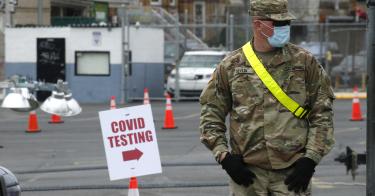If you’ve watched a kids’ soccer game, you know what happens when the ball is kicked from one side of the field to another. Inevitably, every single player races to the ball, egged on by parents and grandparents screaming “Go, go, go! Get the ball, Justin [or Briana]!”
It makes for an exciting game, but it’s not a winning strategy. It’s no way to manage a kids’ sports team, and it isn’t the way to manage our national security.
Protecting the United States requires a far greater constancy of purpose. As a major power, the United States must be prepared to defend against multiple, competing threats simultaneously. The current National Security Strategy acknowledges this, cautioning “the United States faces an extraordinarily dangerous world, filled with a wide range of threats that have intensified in recent years.”
The need to be prepared to respond to a variety of challenges doesn’t allow America the luxury of focusing single-mindedly on one to the detriment of others. Yet some have recently suggested that we do just that—and concentrate solely on the threat of pandemics.
COVID-19 has amply demonstrated that pandemics can upend our American way of life, and the security strategy presciently identified pandemics as carrying the potential for “catastrophic loss of life” and called for better preparation.
Despite being ranked first of 195 countries in global health security and annual federal expenditures of hundreds of millions of dollars on infectious disease preparedness, COVID-19 has claimed tens of thousands of American lives. An after-action evaluation will surely identify a number of areas where the country as a whole can improve its preparation and response efforts, and these should be promptly fixed.
But threats that existed before the emergence of the coronavirus have not magically disappeared. They must be reckoned with, still.
China, Russia, Iran and North Korea all pose growing existential threats to U.S. security. Beijing’s duplicity in the early months of the COVID pandemic starkly illustrate the Chinese Communist Party’s real priorities, and—spoiler alert—they don’t involve maintaining a stable international order. Meanwhile, Russia, Iran and North Korea continue to challenge U.S. interests on a daily basis.
Considering this spectrum of dangers, a group of 12 experts comprising the bipartisan National Defense Strategy Commission found “the security and wellbeing of the United States are at greater risk than at any time in decades” and concluded, “put bluntly, the U.S. military could lose the next state-versus-state war it fights.”
When in the grip of an epidemic, it may be tempting to suggest that the U.S. swiftly shift its priorities away from building a strong military and toward pandemic preparation. But the nation can ill afford to ignore even more deadly external threats to focus on the one that happens to be most pressing on our minds.
Despite recent improvements, America’s military is still in need of continued rebuilding and investment. The Air Force is small and older than at any time since its inception. The Navy has far fewer ships than what experts say it needs and is the smallest it has been since 1916. Capabilities such as cyber, space and nuclear deterrence also need refreshing.
Just like a N95 mask or a ventilator, adequate military capabilities are also necessary to keep us safe.
Yes, we must get our federal budget under control. But spending on national defense, as a percentage of the federal budget and gross domestic product, is at a historic low and dropping every year.
No one argues that defense spending should be exempt from scrutiny, but finding realistic solutions to the nation’s fiscal problem means examining the areas that are actually driving our deficits. What’s doing that is out-of-control entitlement spending.
For the sake of our nation, we can and must both prepare for future pandemics and build a strong military. As former Secretary of Defense Jim Mattis said, “America can afford survival.”
This piece originally appeared in The Washington Times



